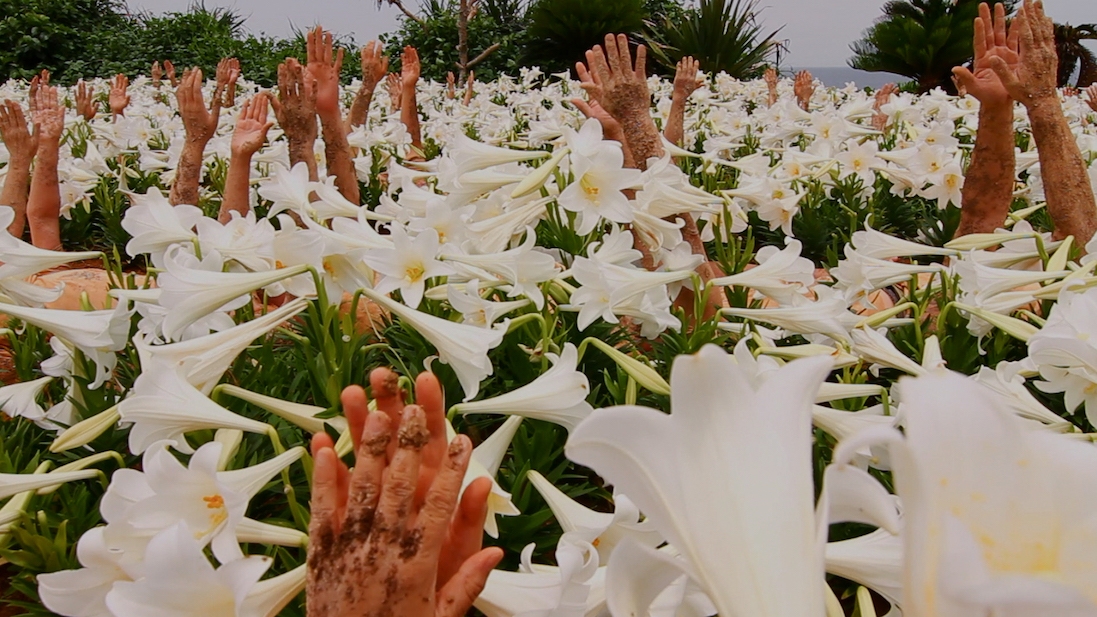The sight of Chikako Yamashiro floating face-up among a bed of seaweed, her eyes half-closed, made me think of the uminchu and haenyeo. These women from Okinawa, Japan and Jeju, South Korea, practice a dying art, freediving for shellfish and seaweed. In both places their trade has been threatened by the industrialisation and militarisation of the region. Activist organisations such as Save Jeju Now – formed to protest the opening of South Korea’s newest naval base in the fishing village of Gangjeong in 2016 – and Henoko Blue – canoeists who have staged sea sit-ins outside a US naval base on the east coast of Okinawa – have united in their attempts to protect local heritage, trades and marine life from these threats.
Yamashiro’s photographs – part of a series called Seaweed Woman (2008) depicting the artist adrift in the sea – accompanies a video shot from a first-person perspective, projected onto a screen hanging in the middle of the gallery, which recreates the experience of diving underwater and surfacing for air in the harbour of Henoko. The sound of rhythmic breathing and gentle laps of water fill the space and so, by emulating the way that Yamashiro uses her own body to occupy threatened sites, implicates the visitor in sea-swimming and in protest against the endangerment of the natural environment.
In Okinawa Tourist (2004), comprised of three videos showing on separate television screens, the artist critiques the tendency to gloss over the island’s traumatic history and present-day tensions. In one of the videos, I like Okinawa Sweet, the artist leans languidly, in sweltering heat, against the chainlink fence of a US military base, devouring one ice cream after another as sweat and sweet cream drip down her face and hands; in Trip to Japan she shouts false ’facts’ about Okinawa; in Graveyard Eisa, men in rolled-up suit trousers and white shirts, with cotton bags over their heads, perform a traditional dance inside a cemetery. In each of these short performances, Yamashiro conflates a tourist promo aesthetic with acerbic commentary on her homeland: the best known brand of ice cream in Okinawa is Blue Seal, created by the US military for soldiers stationed on the island; the tourist industry favours invented narratives over more difficult histories; do the men in office-wear represent Japanese officials, wilfully blind to the US’s creeping occupation?
The most compelling work in the show is her most recent film, a single-channel version of Mud Man (2017), a previous iteration of which won Yamashiro the 2017 Asian Art Award. Set in Jeju and Okinawa, both popular honeymoon ‘hotspots’ and both sites of atrocities during and after the Second World War, the film is accompanied by flowing diegetic sound and a chorus of whispering, more audible speech and beatboxing. The film’s catalyst takes the form of mud lumps which, falling from the sky, awaken a group of people slumbering in a field. The mud whispers to them and their faces become anguished as they realise the dead speak to them from the earth; they slip onto another plane, where they witness the brutality of ground warfare, at once an act of mythologising and revealing shared and inherited memories. Yamashiro employs landscape, as much as the human body, to confront contemporary issues and historical traumas: from the muddy fields like those in which thousands of people were massacred during the 1948 communist uprising in Jeju, to the present-day militarised seaside town of Gangjeong, the land- and seascape becomes the body of the people.
The film, spoken in Japanese and Korean, does not use subtitles. And it is flawless. Its refusal to make the spoken parts understood by anyone who does not speak either language only lends it greater force – as if to say, you can’t understand? Then you can watch. At the close of the film, sounds of warfare are slowly replaced by a rapid cadence of clapping hands, the drumming so intense it feels like the pace of your blood picks up the rhythm. In Mud Man, the elements of sea and land, body and spirit, the people and politics are perfectly combined. It is hard to forget.
Chikako Yamashiro: Shapeshifter at White Rainbow, London, 15 March – 28 April
From the Summer 2018 issue of ArtReview Asia
